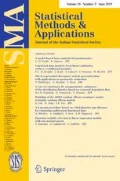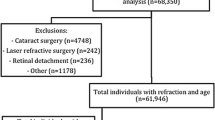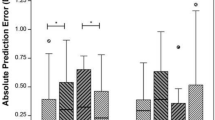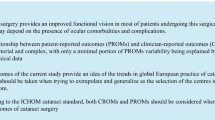Abstract
Cataract surgery is a common procedure that involves removing the cataractous lens of the eye and implanting a new clear plastic lens, with a goal of improving vision and often changing the refraction of the eye. Unexpected refractive outcomes, or refraction prediction error (PE), may be more likely to occur among patients with certain preexisting ocular conditions. However, longitudinal refractive measurements are often missing after surgery, making it difficult to accurately assess which ocular comorbidities lead to increased PE. Moreover, patients with ideal refractive outcomes in one or both eyes may be less likely to return to the clinic, thus more likely to have missing measurements that are missing not at random (MNAR). Despite this potential complication to data analysis, very few studies evaluating PE address the missing data mechanism and the effect it may have on the results. We propose the application of a shared parameter model to reduce bias in situations of MNAR data and compare this to a linear mixed model that is not able to account for this mechanism. We also conduct a simulation study to better understand the most plausible missing mechanism in our study and to characterize situations in which the shared parameter model may be necessary. Applied to the cataract surgery data, the shared parameter model gives similar results as the linear mixed model, finding that a history of LASIK, PRK, RK, high myopia, hyperopia, astigmatism, or combined surgery lead to increased PE. In addition, the simulations confirm that under certain scenarios, a shared parameter model will greatly reduce bias in situations of MNAR.


Similar content being viewed by others
Code availability
Portions of the code used for the study will be included as an appendix.
References
Albert PS (2019) Shared random parameter models: a legacy of the biostatistics program at the National Heart. Lung Blood Inst Stat Med 38:501–511. https://doi.org/10.1002/sim.8011
Bacchetti P (2013) Logarithmic Transformation. https://www.ctspedia.org/do/view/CTSpedia/LogTransformation
Brilleman SL et al (2019) Joint longitudinal and time-to-event models for multilevel hierarchical data. Stat Methods Med Res 28:3502–3515. https://doi.org/10.1177/0962280218808821
Bunce C, Quartilho A, Freemantle N, Doré CJ (2016) Ophthalmic statistics note 8: missing data—exploring the unknown. Br J Ophthalmol 100:291. https://doi.org/10.1136/bjophthalmol-2015-307821
Congdon N et al (2013) Assessment of cataract surgical outcomes in settings where follow-up is poor: PRECOG, a multicentre observational study. Lancet Global Health 1:e37–e45. https://doi.org/10.1016/S2214-109X(13)70003-2
De Gruttola V, Tu XM (1994) Modelling progression of CD4-lymphocyte count and its relationship to survival time. Biometrics 50:1003–1014
Feng C, Wang H, Lu N, Chen T, He H, Lu Y, Tu XM (2014) Log-transformation and its implications for data analysis Shanghai Arch. Psychiatry 26:105–109. https://doi.org/10.3969/j.issn.1002-0829.2014.02.009
Follmann D, Wu M (1995) An approximate generalized linear model with random effects for informative missing data. Biometrics 51:151–168
Gupta S, Ravindran RD, Subburaman GBB, Vardhan SA, Ravilla T (2019) Evidence on importance of follow-up visits after cataract surgery. Ophthalmology 126:910–912. https://doi.org/10.1016/j.ophtha.2018.12.044
Ibrahim JG, Molenberghs G (2009) Missing data methods in longitudinal studies: a review. Test (madr) 18:1–43. https://doi.org/10.1007/s11749-009-0138-x
Kugelberg M, Lundstrom M (2008) Factors related to the degree of success in achieving target refraction in cataract surgery: Swedish National Cataract Register study. J Cataract Refract Surg 34:1935–1939. https://doi.org/10.1016/j.jcrs.2008.06.036
Lundstrom M et al (2018) Risk factors for refractive error after cataract surgery: analysis of 282 811 cataract extractions reported to the European registry of quality outcomes for cataract and refractive surgery. J Cataract Refract Surg 44:447–452. https://doi.org/10.1016/j.jcrs.2018.01.031
Molenberghs G, Fitzmaurice G, Kenward MG, Tsiatis A, Verbeke G (2014) Handbook of missing data methodology. CRC Press
Norrby S (2008) Sources of error in intraocular lens power calculation. J Cataract Refract Surg 34:368–376. https://doi.org/10.1016/j.jcrs.2007.10.031
Prager TC, Hardten DR, Fogal BJ (2006) Enhancing intraocular lens outcome precision: an evaluation of axial length determinations, keratometry, and IOL formulas. Ophthalmol Clin 19:435–448. https://doi.org/10.1016/j.ohc.2006.07.009
Rubin DB (1976) Inference and missing data. Biometrika 63:581–592. https://doi.org/10.2307/2335739
Savini G, Hoffer KJ (2018) Intraocular lens power calculation in eyes with previous corneal refractive surgery. Eye Vision 5:18. https://doi.org/10.1186/s40662-018-0110-5
Stein JD (2012) Serious adverse events after cataract surgery. Curr Opin Ophthalmol 23:219–225. https://doi.org/10.1097/ICU.0b013e3283524068
Ten Have TR, Kunselman AR, Pulkstenis EP, Landis JR (1998) Mixed effects logistic regression models for longitudinal binary response data with informative drop-out. Biometrics 54:367–383
Thomadakis C, Meligkotsidou L, Pantazis N, Touloumi G (2019) Longitudinal and time-to-drop-out joint models can lead to seriously biased estimates when the drop-out mechanism is at random. Biometrics 75:58–68. https://doi.org/10.1111/biom.12986
Tseng CH, Elashoff R, Li N, Li G (2016) Longitudinal data analysis with non-ignorable missing data. Stat Methods Med Res 25:205–220. https://doi.org/10.1177/0962280212448721
Tsonaka R, Rizopoulos D, Verbeke G, Lesaffre E (2010) Nonignorable models for intermittently missing categorical longitudinal responses. Biometrics 66:834–844. https://doi.org/10.1111/j.1541-0420.2009.01365.x
Wu MC, Carroll RJ (1988) Estimation and comparison of changes in the presence of informative right censoring by modeling the censoring process. Biometrics 44:175–188. https://doi.org/10.2307/2531905
Yeh OL, Bojikian KD, Slabaugh MA, Chen PP (2017) Refractive outcome of cataract surgery in eyes with prior trabeculectomy: risk factors for postoperative myopia. J Glaucoma 26:65–70. https://doi.org/10.1097/ijg.0000000000000560
Funding
Support from a Challenge Grant to the Department of Ophthalmology from Research to Prevent Blindness, Inc.
Author information
Authors and Affiliations
Contributions
All authors contributed to the study conception and design. Data collection and analysis were performed by DCM. The analysis was supervised by BW and SMW. The first draft of the manuscript was written by DCM and all authors commented on previous versions of the manuscript. All authors read and approved the final manuscript.
Corresponding author
Ethics declarations
Conflict of interest
The authors declare that they have no conflict of interest.
Availability of data
The dataset generated and analyzed during the current study will be made available upon request.
Ethics approval
All procedures performed in studies involving human participants were in accordance with the ethical standards of the Colorado Multiple Institutional Review Board (protocol # 17–0629) and with the 1964 Helsinki declaration and its later amendments or comparable ethical standards.
Additional information
Publisher's Note
Springer Nature remains neutral with regard to jurisdictional claims in published maps and institutional affiliations.
Appendices
Appendix
SAS code for linear mixed model and shared parameter model applied to cataract surgery data

Rights and permissions
About this article
Cite this article
Miller, D.C., MaWhinney, S., Patnaik, J.L. et al. Predictors of refraction prediction error after cataract surgery: a shared parameter model to account for missing post-operative measurements. Stat Methods Appl 31, 343–364 (2022). https://doi.org/10.1007/s10260-021-00570-w
Accepted:
Published:
Issue Date:
DOI: https://doi.org/10.1007/s10260-021-00570-w




